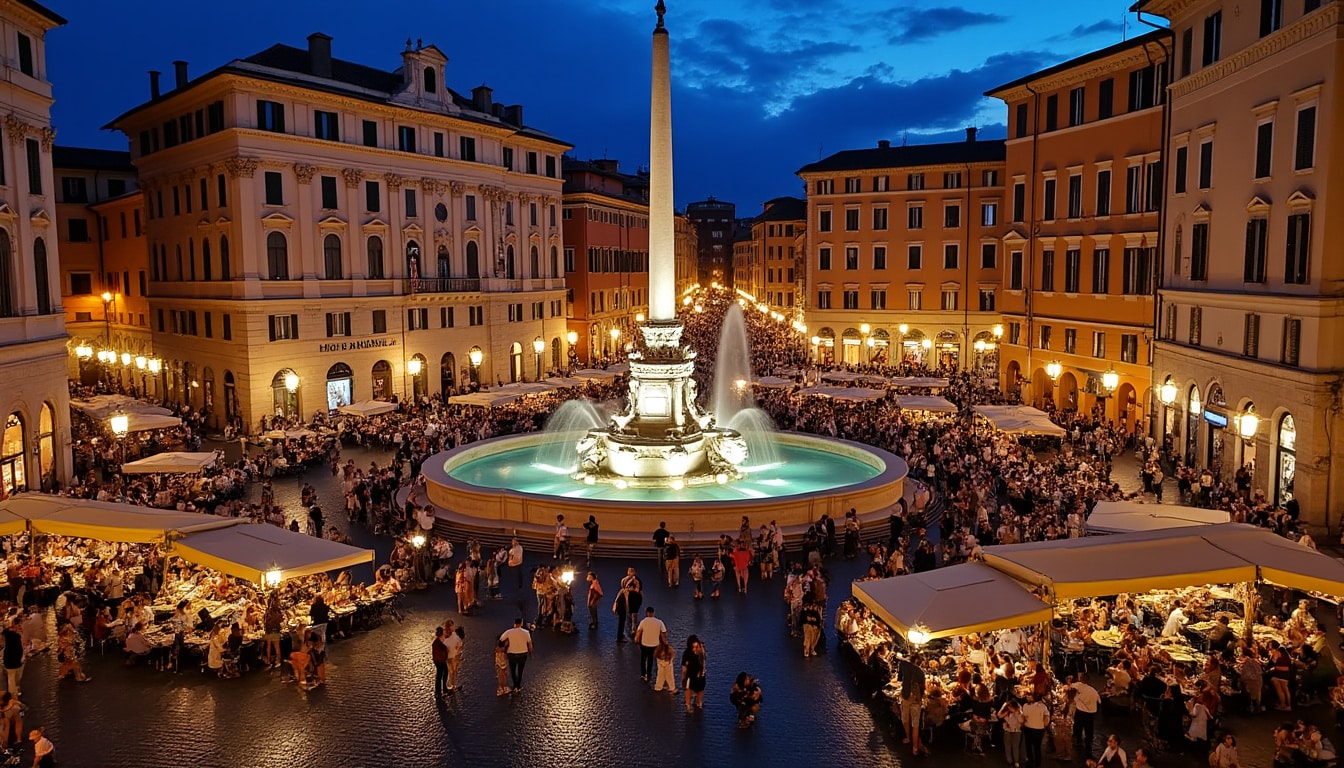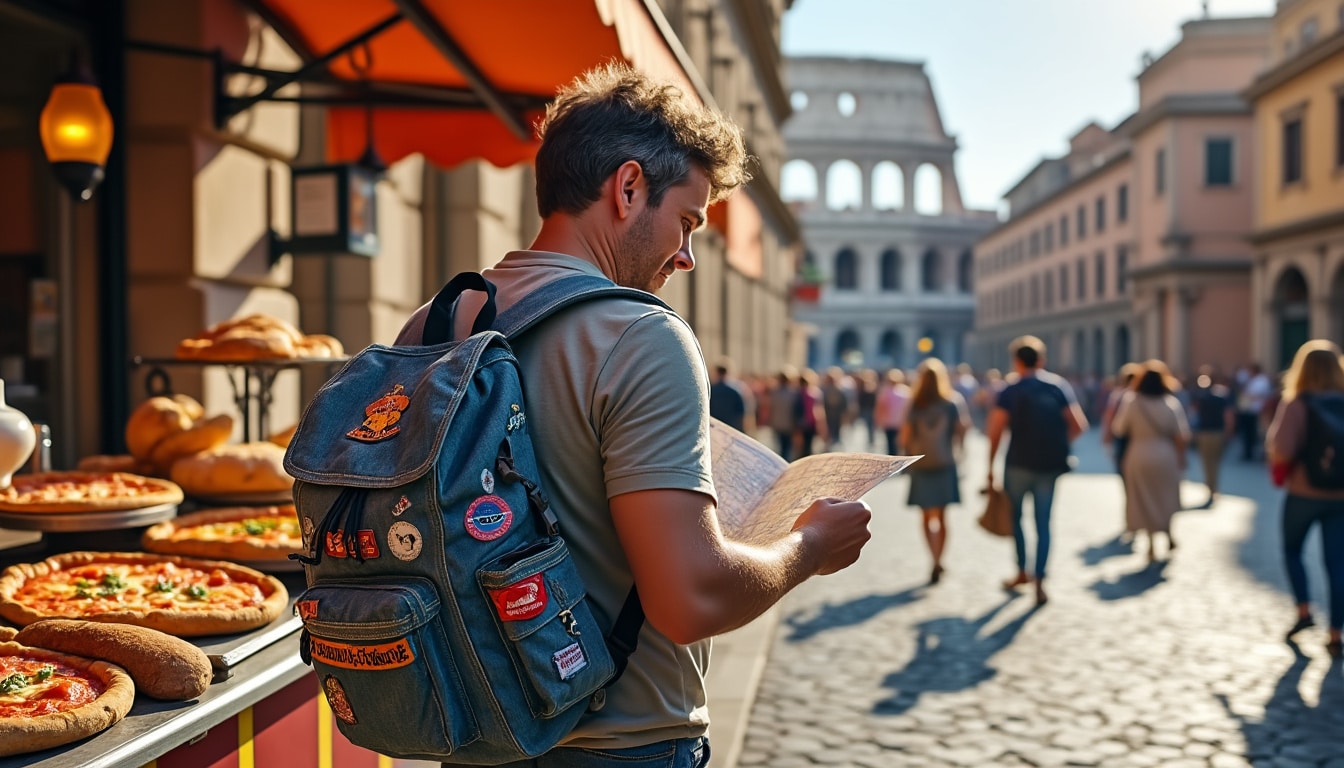Rome, with its rich tapestry of history, art, and bustling street life, is often a dream destination for many. Yet, visiting this ancient city doesn’t have to break the bank. Whether it’s sipping an espresso in a bustling piazza or stepping back in time as you wander through ancient ruins, Rome offers a plethora of experiences that can suit every budget. From strategic accommodation choices to smart sightseeing, travelers can discover the Eternal City without compromising on an authentic experience. Here are some practical tips to help you navigate Rome like a local, saving money while soaking in its vibrant culture.
Stay Near Campo de’ Fiori for an Authentic Roman Experience
One of the most effective ways to save money while traveling is by choosing your accommodation location wisely. Campo de’ Fiori is an ideal base for budget-conscious travelers seeking convenience and charm. This historic market square has been a gathering spot since 1869, offering an authentic taste of Rome’s vibrant daily life. Surrounded by cafes, wine bars, and bustling marketplaces, it provides easy access to many of Rome’s iconic landmarks.
Accommodation options around Campo de’ Fiori range from budget B&Bs to affordable hostels such as those found on Hostelworld and Booking.com. Staying in this area not only keeps you centralized, reducing the need for costly transportation, but also immerses you in Roman culture. As evening falls, the square morphs into a lively hub of activity, perfect for enjoying Rome’s nightlife without spending a fortune.
- 🌟 Experience the local market during morning hours for a quintessential Roman scene.
- 🍕 Enjoy a slice of traditional pizza bianca from Forno Campo de’ Fiori, a local favorite.
Booking accommodations via platforms like Expedia can also offer competitive rates, especially if booked in advance. Remember, booking your rooms around this area means being just a short stroll away from attractions like the Pantheon and Piazza Navona.

Maximize the Benefits of the Rome Tourist Card
For those keen on exploring Rome’s vast array of historical sites, the Rome Tourist Card offers a cost-effective solution. This all-in-one discount pass provides access to major attractions such as the Colosseum, Vatican Museums, and choice between the Pantheon or St. Peter’s Basilica, coupled with a 10% discount at numerous other sites.
Opting for this card is particularly beneficial for first-time visitors with a two or three-day itinerary in mind. By securing your visits in advance, you’ll sidestep lengthy queues, a notorious feature of Rome’s most popular sites. It’s crucial, however, to book your Colosseum time slots early in the day to beat the crowds—these bookings can be effortlessly completed on platforms like TripAdvisor and Skyscanner.
| Attraction | Discount with Card | Recommended Time to Visit |
|---|---|---|
| Colosseum | 10% off | Early Morning |
| Vatican Museums | 10% off | Around noon for shorter lines |
| Pantheon or St. Peter’s Basilica | Included | Afternoon |
Smart Dining: Avoid Tourist Traps for Authentic Cuisine
Dining in Rome can be both a cultural delight and a budgetary pitfall if one isn’t cautious. Tourist hotspots such as the Colosseum and Trevi Fountain Street are peppered with eateries that often prioritize quantity over quality, serving overpriced and underwhelming meals. To savor authentic Roman cuisine without the steep price tag, venture to local neighborhoods such as Trastevere or Testaccio.
These districts are renowned for their traditional taverns and trattorias where homemade pastas and local wines flow freely at reasonable prices. Restaurants like Da Enzo al 29 and Felice a Testaccio are revered for their culinary authenticity and affordability. Always opt to stroll a few blocks away from main attractions and look for menus sans photos—typically an indication of a more genuine dining experience.
- 🍝 Testaccio offers authentic dishes like carbonara and cacio e pepe.
- 🍷 Try local wines, often house-poured and highly affordable.
Moreover, engaging with review platforms such as Lonely Planet and TripAdvisor can provide insights into less-touristy dining options that assure both quality and local flavor.
Hydrate for Less: Utilizing Rome’s Public Water Fountains
One of the city’s best-kept secrets lies in its hundreds of public water fountains, known as nasoni. Located throughout Rome, these fountains offer clean, cold, and free drinking water. While a single bottle of water in tourist areas can cost up to €4, relying on nasoni can result in significant savings over the course of a trip.
These fountains are a piece of Roman heritage, with each nasone uniquely designed and a part of the city’s historical landscape. Carrying a refillable water bottle not only saves money but also aligns with eco-friendly practices by reducing plastic usage. Before heading out for the day, consult a nasoni map available on travel sites like Rome2rio and ensure you’re never far from the nearest spout.
Explore Rome’s Past by Walking Its Historic Streets
An excellent way to balance cost with exploration is by eschewing public transport for walking tours. The compactness of Rome’s city center makes it ideal for exploration on foot, allowing tourists to soak up the ambiance of ancient streets and iconic landmarks at their own pace. Furthermore, the metro system covers only a fraction of central Rome, making walking not just economical but often the most practical approach.
Investing in a comfortable pair of walking shoes is essential. Rome’s cobblestone streets are picturesque but can be unforgiving on the feet. Some neighborhoods like the Jewish Ghetto or Trastevere are particularly enchanting during golden hour, when the sun casts a warm glow over the historical architecture and the air is filled with the aroma of freshly baked bread.
- 🕌 Discover hidden courtyards and tucked-away gems typically not listed on itineraries.
- ☕ Stop for espresso breaks at local cafes dotted around central Rome for a true taste of the city.
For those seeking more structured exploration, platforms such as GoEuro list various guided walking tours, complete with Rich storytelling that brings the Eternal City to life.
Navigating Rome’s Transport Options
While Rome’s public transport isn’t comprehensive, it serves well for longer commutes across the city. Trams and buses complement the metro system, and purchasing integrated tickets gives access to all transport modes. Travelers can look up routes and schedules on Kayak or Skyscanner for best results.
Opt for single tickets if you’re saving for a few days, or purchase daily passes for unlimited travel. Ride-sharing apps provide an alternative to taxis, often outpricing traditional options. With a strategic mindset and savvy travel techniques, roaming Rome on a budget becomes feasible.
FAQs
What is the best area to stay in Rome for first-timers?
Staying near Campo de’ Fiori provides easy access to major sights without the hefty crowd numbers often found in tourist-heavy districts.
Is pre-booking necessary for Vatican tickets?
Yes, especially during peak seasons. Skip-the-line options available on sites like Booking.com are highly recommended to avoid long waits in line.
Are public water fountains safe to drink from?
Indeed, Rome’s nasoni fountains provide safe, potable water free of charge and are scattered throughout the city, making them accessible.
What are must-try dishes in Rome?
Traditional Roman dishes such as carbonara, cacio e pepe, and amatriciana are must-tries, especially in local areas like Trastevere or Testaccio.
How can I avoid tourist restaurant scams?
Venture a few blocks away from main attractions and choose restaurants with non-photographed menus to ensure a genuine Roman experience. Platforms like Lonely Planet can help identify authentic dining locations.

